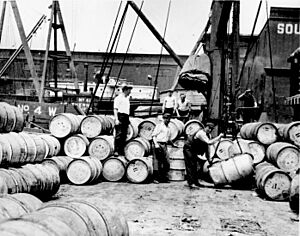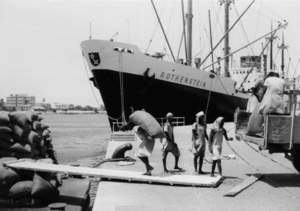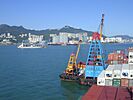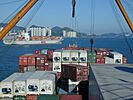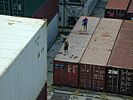Dockworker facts for kids
A dockworker is a person who loads and unloads ships at a port. You might also hear them called a longshoreman, stevedore, or docker. Their job is to move cargo from the land onto a ship, or from a ship onto the land.
Over time, the way ships are loaded has changed a lot. Because of the invention of shipping containers, the number of dockworkers needed has gone down a lot since the 1960s.
Contents
What Do We Call Dockworkers?
The word stevedore comes from Portugal or Spain. It means "a person who loads ships and stores cargo." In Great Britain and Ireland, these workers are usually called dockers. In Australia, they are called stevedores, dockworkers, or wharfies. In the United States and Canada, the term longshoreman is often used. This word comes from "man-along-the-shore."
Before large shipping containers became common, longshoremen usually worked on the docks. Stevedores often worked on the ships themselves, using cranes and moving cargo.
A Brief History of Dockworkers
Dockworkers have been important for trade for thousands of years. Their job has changed a lot as ships and trade have become more modern.
Ancient Times: Early Port Workers
In ancient times, people like the Phoenicians, Greeks, and Romans needed dockworkers. These workers loaded and unloaded goods from ships in busy port cities. Famous ancient ports include Carthage, Athens, and Ostia.
Medieval Period: Trade in Europe
During the Middle Ages, dockworkers were key to trade in Europe. Groups like the Hanseatic League, a powerful trading group, hired dockworkers. They handled goods in major ports like Lübeck and Bruges.
Industrial Revolution: Steam and Unions
The Industrial Revolution brought steam-powered ships and railways. This meant more goods were traded, and they needed to be handled faster. Dockworkers started to form unions to protect their rights and improve working conditions. An example is the International Longshoremen's Association in the United States.
Containerization: A Big Change
In the late 20th century, containerization changed shipping forever. Goods were put into large, standard containers. This made loading and unloading much faster and more efficient. As a result, the number of dockworkers needed dropped by a lot. The workers who remained mostly learned to operate heavy machinery like cranes. This change also helped global trade grow a lot.
How Ships Are Loaded and Unloaded Today
Loading and unloading ships needs special skills. Workers must know how to use loading equipment and how to properly lift and store cargo. They also need to handle any dangerous goods safely. Dockworkers must be strong and able to follow instructions carefully. They work quickly because ships can only stay in port for a short time.
Before Containers: Manual Work
In the past, before containers, dockworkers had to tie down cargo with ropes. They used special knots, like the stevedore knot. Tying goods securely was called stevedore lashing. When loading a general cargo ship, they used dunnage. This was wood or inflatable bags placed to keep cargo dry or to secure crates. A common tool was the longshoreman’s hook, which became a symbol of the job.
Traditionally, dockworkers did not have a fixed job. They would go to the docks each morning hoping to find work for the day. In London, this was called standing on the stones. In the United States, it was called shaping up.
With Containers: Modern Operations
Today, most non-bulk cargo travels in shipping containers. These containers arrive at the port by truck, train, or another ship. They are then stacked in a storage area.
When a ship arrives, a large crane unloads its containers. These containers then leave the port by truck or train, or they are stored for another ship. Once the ship is empty, new containers are brought to the dock by trucks. A crane lifts these containers onto the ship. As the containers are stacked, workers connect them to the ship and to each other.
Modern dockworker jobs include:
- Crane operators
- Workers who connect containers on the ship
- Truck drivers who move containers around the port
- Workers who track containers in the storage area
- Various supervisors
These workers are all considered stevedores or dockworkers. Dockworkers have also played a big role in the modern labor movement, fighting for better conditions and rights.
Famous People Who Were Dockworkers
Many people who became famous once worked as stevedores or dockworkers:
- Crispus Attucks – An American patriot.
- Harry Bridges – He founded the [[International Longshore and Warehouse Union (ILWU)].
- Joey Coyle – His story inspired the movie Money for Nothing.
- Jack Dash – A British dock workers' union leader.
- Peter Fraser – He was the Prime Minister of New Zealand from 1940 to 1949.
- Danny Greene – An American mobster.
- Eric Hoffer – A philosopher and social critic.
- Patrick Joseph "P.J." Kennedy – An American businessman and grandfather of President John F. Kennedy.
- Keith William Richards – An actor.
- Artie Lange – An actor and comedian.
- Tom Mann – A British trade unionist who helped organize the London Dock Strike of 1889.
- Peter MacKay – A Canadian former government minister. He worked as a stevedore for two summers as a teenager.
- Bruce Nelson – A labor historian and author.
- Benito Quinquela Martín – A painter from Buenos Aires, Argentina. His art often showed life at the docks.
- Stan Weir – A sociologist and writer.
See also
- 1913 Sligo Dock strike
- Admiralty law
- Battle of Ballantyne Pier (Canada)
- Dockers Union (disambiguation)
- Dunnage
- Federated Ship Painters and Dockers Union
- History of Squamish and Tsleil-Waututh longshoremen, 1863–1963
- International Longshore and Warehouse Union (United States)
- Liverpool dockers' strike (1995–98) (UK)
- Mersey Docks and Harbour Company
- Mudlark
- National Union of Dock Labourers


